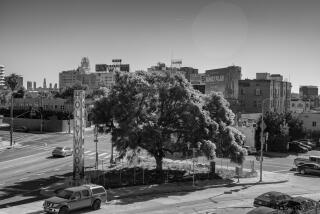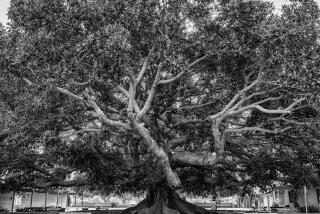Scrappy Christmas tree prompts a change of heart in Reading, Pa.

This is a tale of two trees.
One is draped in holiday lights and topped with a star, and it is most people’s vision of what a city’s Christmas tree should be. That one sits a few blocks from the center of town.
The other is — well, here are a few comments uttered one day as people eyed the Norway spruce that is Reading’s official holiday tree, the one with the weeping branches that sits in the heart of downtown.
“Kinda sad.”
“Scary.”
“I wouldn’t bring my kids to see it.”
But Karen Grinnage looked at the droopy, somewhat balding tree, naked of ornaments save for an oversize red ball hanging from a branch near the town clock. She saw something else.
“I see one ball, and I see one clock, and I see that it’s time to make one world,” she said firmly.
Finally, it seemed, someone had grasped the message city leaders hoped to send when they chose this tree to stand downtown, instead of the beautifully decorated one a few blocks away.
Reading’s embrace of its Charlie Brown tree became official Sunday with a ceremony that would have been silly, if the meaning behind it were not serious.
Mayor Vaughn Spencer and City Council members who had been on opposite sides of the tree dispute gathered in front of it as a small group of locals and out-of-towners took pictures of the scene.
“I’m just happy,” said Francis Acosta, the City Council president who led an initial fight to get rid of the tree. Acosta said he believed most people still would have preferred a nicer tree, but this one would do just fine.
Someone dressed in a Santa suit wandered among the crowd as David Kline, a local radio and TV personality, compared the tree to the misfit chosen by Charlie Brown in “A Charlie Brown Christmas.” Just as that tree showed Charlie Brown, Lucy and the gang the true meaning of Christmas, so too should this one, Kline said before reading aloud from the holiday special written by Charles M. Schulz in 1965.
“To me, the true meaning of Christmas is appreciating everything you have,” Jeffrey Waltman, a City Council member who always supported the tree, said before the brief ceremony. “It’s to love everything.”
Reading could use some love. For several years, census figures have ranked it among the poorest cities in America, with about 40% of its 88,000 people living in poverty. The main street where the tree sits reflects Reading’s financial despair. Bargain bazaars dominate. There is a smoke shop, a pawnshop, a small storefront offering check-cashing services and a handful of fast-food outlets.
Like a lot of the cities that depended on the railways, steel, and manufacturing, Reading began losing its jobs and tax base decades ago when those industries died or took their factories elsewhere. Today Latinos, many of whom moved about 100 miles west from New York City in search of more affordable living, make up more than half of Reading’s population. Few of them have the college degrees that could help them find decent-paying jobs, even if such jobs existed here.
It is a Christmas miracle that the tree survived this long, much less had its own special dedication. City workers plucked it from a park as a last-ditch substitute shortly before Thanksgiving when mud prevented them from getting to the beautiful tree they had been sent to fetch from a nearby farm.
Rather than return empty-handed, they grabbed the closest big tree available and erected it in Penn Square, where Reading’s holiday tree sits each year.
Thus began the war of the trees.
City Hall’s phones began ringing off the hook, with about half the callers complaining about the tree. Acosta led the fight, even donating a 20-foot beauty to replace the Charlie Brown job.
At the same time, a group formed to preserve the tree. Someone topped it with a lighted pretzel, a nod to the city’s many pretzel bakeries, and it was draped in lights.
Their fight appeared futile. One day, public works employees showed up with equipment to evict the “ugly tree,” as it had been dubbed, and erect Acosta’s pretty tree.
But fate intervened.
Snow was coming. The city had a budget to vote on. And news cameras and reporters were gathering in Penn Square to record what was becoming an awkward moment.
At the last minute, the tree swap was canceled.
“We will keep this thing here,” Acosta said that day. His tree was displayed up the street, out of sight of downtown shoppers and admirers of the Charlie Brown tree.
Not everyone was happy with the outcome.
“I wouldn’t choose a tree like that,” Angel Otero said of the Charlie Brown tree.
Jovella Vandison agreed. “This doesn’t scream holiday to me,” she said.
Louis Feliciano said the tree only added to Reading’s hard-luck image. “This is the center of the city. It’s traditional to have a big tree, but this is not tradition,” he said.
“They better have a lot of things to fill the gaps,” added Stephanie Whitman, Feliciano’s fiancee.
Rick Dungey, executive director of the National Christmas Tree Assn., said he was not surprised by the disagreement over Reading’s tree.
“I learned many, many years ago that trying to tell people what a ‘good’ Christmas tree was and what a ‘bad’ Christmas tree was is a pointless endeavor,” Dungey said. As long as it’s a real tree, not a plastic or metal one, any tree is a good choice, he said.
Amid the squabbling, several people pointed out that however shabby the Reading tree might look, it had done the unexpected: brought people together to talk about a contentious issue in a peaceful manner, at a time when cities across the country were being rocked by angry protests over the deaths of two unarmed black men at the hands of police.
“This is a new role for a tree,” said Mimi Schmitt, who came with her husband, Erich, to take pictures of the tree. Their critical view softened after Grinnage chimed in, defending the tree and its lone ornament as a symbol of unity.
Carlos Vasquez, an unemployed welder who delivers pizzas part time to make ends meet, conceded the tree is far from perfect. That’s what makes it ideal for Reading, he said.
“Christmas is not perfect,” Vasquez said. “You have a lot of people who can’t afford presents. You have a lot of people who are homeless.”
Even if the tree looks a bit shabby, he said, it was something everyone could share.
“It’s the thought that counts,” he said. “That’s the Christmas spirit.”
Twitter: @tinasusman
More to Read
Start your day right
Sign up for Essential California for news, features and recommendations from the L.A. Times and beyond in your inbox six days a week.
You may occasionally receive promotional content from the Los Angeles Times.







